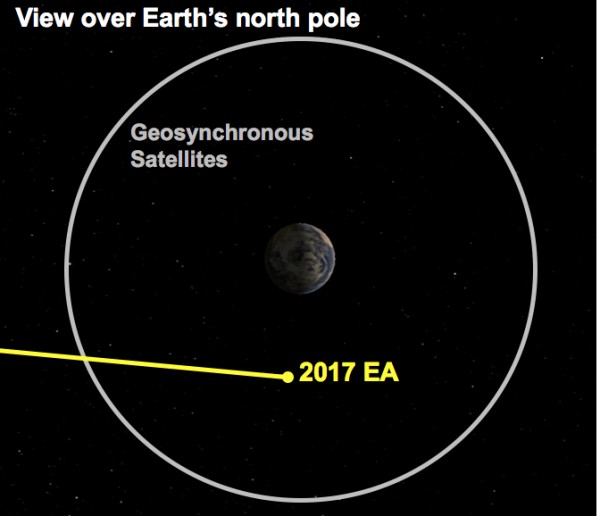By Ana Verayo, | March 07, 2017

Asteroid 2017 EA Close Approach to Earth on March 2, 2017
Last week, a small, near Earth asteroid passed by closer than any communications or any weather satellite in orbit at 20 times closer than the moon. This small asteroid zipped by our backyard at 9,000 miles from our planet.
This tiny asteroid is known as 2017 EA that passed by last Thursday, March 2 around 9:04 A.M. EST just above the east Pacific Ocean. According to scientists from the NASA's Center for Near-Earth Object Studies this tiny asteroid was travelling at a distance comparable to 1/20th of the distance of Earth from the moon. NASA officials also revealed that this asteroid will not be back for more than a century.
Like Us on Facebook
Astronomers at the Catalina Sky Survey in Arizona were able to detect this asteroid some six hours before it flew within its closest approach. Many observatories from different parts of the world were also able to monitor this asteroid as it approached Earth. When it passed by, the tiny asteroid instantly disappeared under Earth's shadow before its closest point to our planet.
This asteroid was able to enter beyond the geosynchronous orbit where most satellites are located and is also the farthest orbital point from Earth. Usually satellites stay in this far region over a specific area above Earth. This orbital path is ideal for communication services to operate and also to survey or monitor a region on the surface of Earth.
According to Carrie Nugent from Caltech's Infrared Processing and Analysis Center under NASA, if asteroid 2017 EA would enter into Earth atmosphere, this three meter wide asteroid will not become much of a worry. Nugent adds, this tiny asteroid would have burned up very quickly and might even create a dazzling light show and even a meteorite shower, or not. Nugent explains how this will depend on the exact composition of the asteroid, where astronomers can predict the effects of an asteroid or comet entering our skies.
Asteroid 2017 EA possesses an elliptical orbit around the sun as astronomers continue to study and monitor this small space rock. Scientists assure that this one will not visit Earth soon, not for more than a hundred years or so.
-
Use of Coronavirus Pandemic Drones Raises Privacy Concerns: Drones Spread Fear, Local Officials Say

-
Coronavirus Hampers The Delivery Of Lockheed Martin F-35 Stealth Fighters For 2020

-
Instagram Speeds Up Plans to Add Account Memorialization Feature Due to COVID-19 Deaths

-
NASA: Perseverance Plans to Bring 'Mars Rock' to Earth in 2031

-
600 Dead And 3,000 In The Hospital as Iranians Believed Drinking High-Concentrations of Alcohol Can Cure The Coronavirus

-
600 Dead And 3,000 In The Hospital as Iranians Believed Drinking High-Concentrations of Alcohol Can Cure The Coronavirus

-
COVID-19: Doctors, Nurses Use Virtual Reality to Learn New Skills in Treating Coronavirus Patients







